#Frank Merriwell
Text


Shadow Comics #01 (Mar1940) / Doc Savage Comics (May1940)
Street And Smith
#Comics#Street And Smith#Shadow#Doc Savage#The Shadow#Vintage#Art#CGC#Shadow Comics#Doc Savage Comics#Iron Munro#Bill Barnes#Frank Merriwell#Captain Fury#Whisperer#The Whisperer#Captain Death#Mark Mallory#Billy The Kid#Pulp Art#Pulp Illustration#Pulp Heroes#1940#1940s#40s#Pulp
23 notes
·
View notes
Text
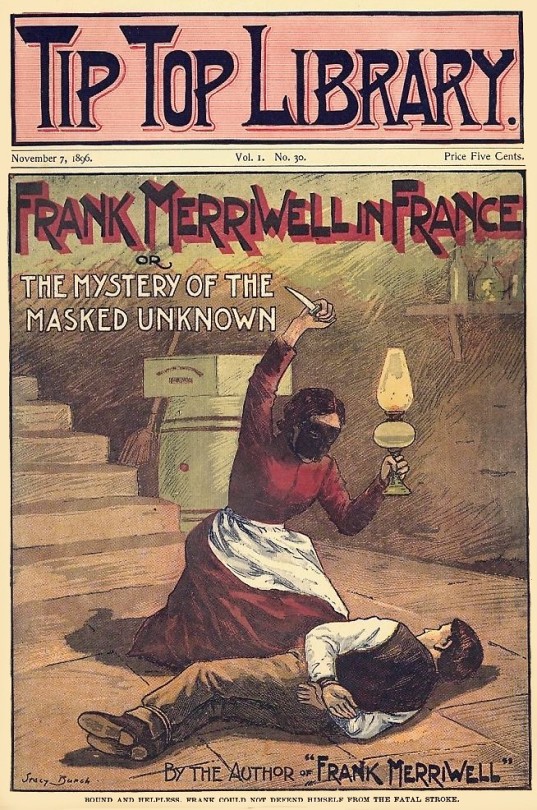
Tip Top Library no. 30: "Frank Merriwell in France; or, The Mystery of the Masked Unknown" by William G. Patten. Published 1896 by Street & Smith Publications.
3 notes
·
View notes
Text
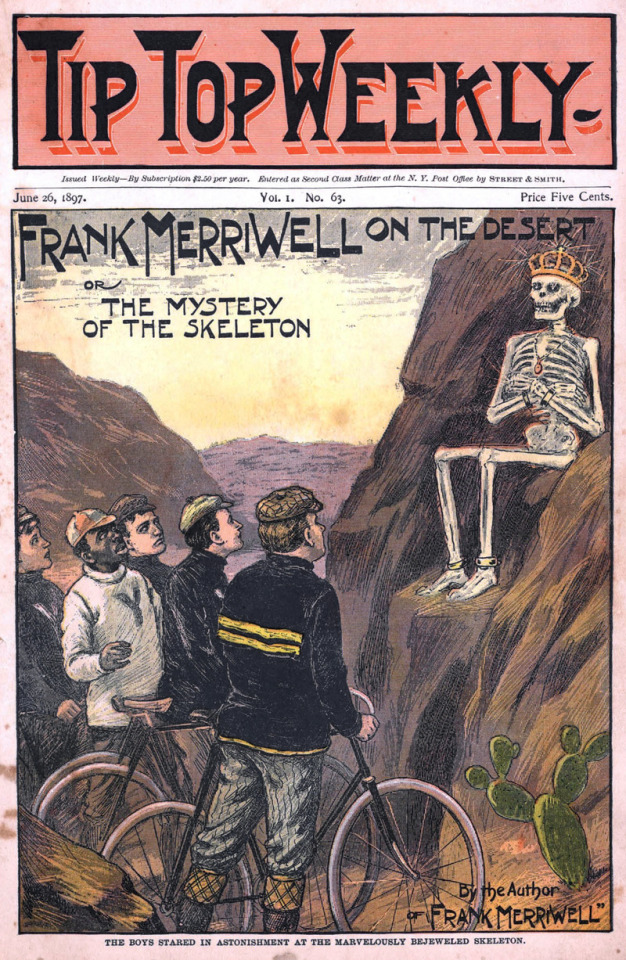
TIP TOP WEEKLY Vol No. 1 #63 (Smith & Street, 1897)
A Frank Merriwell adventure.
#frank merriwell#pulp#pulps#19th century pulp#1800s pulp#skeletons#skeleton#sports pulp#pulp sports#dime novel#dime novels#1890s aesthetic#mystery#mysteries#tip top weekly#pulp magazines#pulp mags#pulp mag#pulp adventure#burt l standish
30 notes
·
View notes
Text

Don Briggs-Jean Rogers-John King "The adventures of Frank Merriwell" 1936, de Clifford Smith, Lew Landers.
5 notes
·
View notes
Note
Do you have any esoteric knowledge, Frank? Do you know any wizards?
My name is Frank Merriwell. I can't read minds or anything, but I get "a vague sense of solidity" when I touch people who do weird stuff
14 notes
·
View notes
Photo

28th January 1911, Donald Briggs was born, who appeared in over 75 films and television shows, between the 1930s and 1970s. He was also the original actor in the radio series, The Adventures of Frank Merriwell, a juvenile role model who played and excelled at all types of sports at Yale University, including football, baseball, basketball, crew and track. The series was first broadcast on NBC radio in 1934 from March 26 to June 22, three times a week in 15-minute continuation stories. Read more, and listen online at https://link.rusc.com/e6fa1900
2 notes
·
View notes
Text

Someone to connect with the younger readers says Kane to the others. A partner in crime-solving (a Watson to the Holmes) thinks Finger, given the names of the pulp characters Frank Merriwell's half-brother 'Dick' and the last name of a book editor Charles 'Grayson'. Given the superhero nam 'Robin' by Jerry Robinson, who adds that the character was based on the image of Robin Hood and that the young ward served to humanize Batman.
Through Dick, Batman became immortal as he helped develop the longevity of the character, giving the series a unique tone by not having it be another grim pulp lacking in humor.
Script: Bill Finger
Pencils: Bob Kane
Inks and Letters: Jerry Robinson
3 notes
·
View notes
Link
https://topbestsimilar.com/book/frank-merriwell/?feed_id=19&_unique_id=65ba02f1958ab Frank Merriwell
0 notes
Video
youtube
Adventures Of Frank Merriwell Radio Show The Missing Mascot otr Old Time...
1 note
·
View note
Photo

Hooded gang dime novel, Tip Top Weekly No. 166, June 17, 1899, "Frank Merriwell Suspected; or, For the Honor of France” by Burt L. Standish (Gilbert Patten?).
The Steam Man of the West
16 notes
·
View notes
Photo
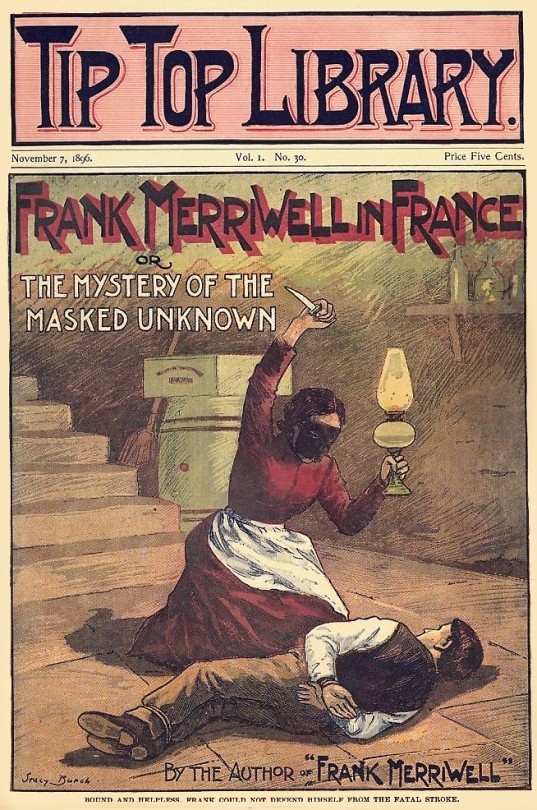
Tip Top Library (Tip Top Weekly) / 1896
Frank Merriwell in France; or, The Mystery of the Masked Unknown
#Tip Top Weekly#1896#Burt L. Standish#Frank Merriwell in France; or The Mystery of the Masked Unknown#cover#art#vintage
42 notes
·
View notes
Text


Vintage Pulp - Fame And Fortune (Nov1928) (#02)
#Pulp#Fame And Fortune#Finance#Capitalism#Pulp Art#Pulp Illustration#Vintage#Art#Illustration#Design#Ads#Advertising#Hair#Frank Merriwell#1928#1920s#20s
77 notes
·
View notes
Text
DONALD BRIGGS
January 28, 1911
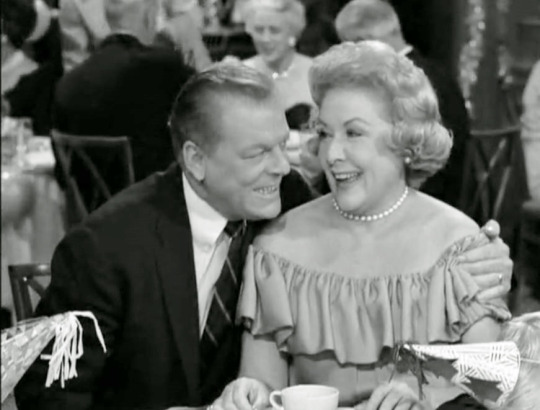
Donald Preston Briggs was born in Chicago, Illinois. On radio, he was a regular in "Death Valley Days", "FBI in Peace and War”, "Perry Mason", "Welcome Valley" and the title role in "Frank Merriwell", which led to his first film, playing Frank Merriwell in the 1936 Universal serial "The Adventures of Frank Merriwell."

The film was broken up into 12 parts for the serialization.

In 1939, he appeared with Lucille Ball in the film Panama Lady. Most interesting is that Ball’s character name is ‘Lucy,’ the first time she ever portrayed a character with that name - though this particular 'Lucy' has nothing in common with Mrs. Ricardo, Mrs. Carmichael, Mrs. Carter, or Mrs. Barker!
He continued acting in films until he made his TV debut on June 28, 1950 in a “Stage 13″ presentation titled “No More Wishes”.
During the summer of 1962, Briggs was cast to play Eddie Collins on Lucille Ball’s new television series, “The Lucy Show.” Eddie Collins was Vivian Bagley’s on-again / off-again boyfriend. Briggs did six episodes of the series before the character was written out early in season two.
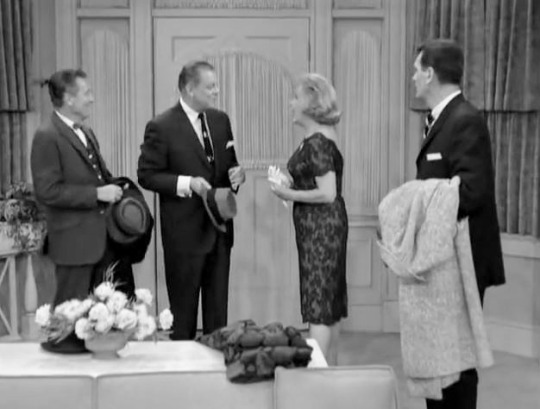
The character made his debut in “Lucy Digs Up a Date” (TLS S1;E2) aired on October 8, 1962. It is established that Eddie and Viv are not in a serious relationship, but do date on occasion.

In “Lucy Builds a Rumpus Room” (TLS S1;E11) first aired December 10, 1962 we learnt that Eddie Collins travels a lot as part of his job. This might account for his 9 week absence from the series!

At “Chris’s New Year’s Eve Party” (TLS S1;E14) aired on December 31, 1962, Eddie participated in Lucy’s silent movie sketch as a tough guy (striped shirt and cap).
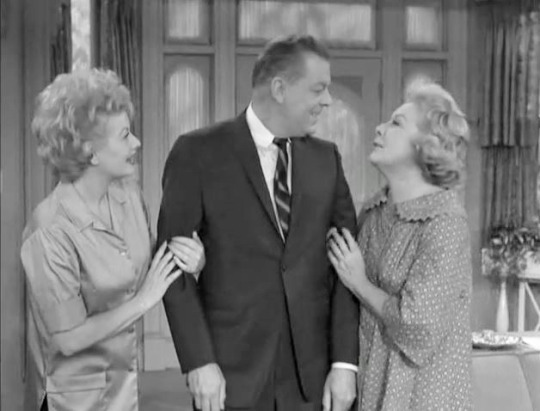
When “Lucy and Viv Put in a Shower” (TLS S1;E18) aired on January 28, 1963, we learned that Eddie’s pet name for Viv is ‘Tootsie’!

When “Lucy and Viv Become Tycoons” (TLS S1;E20) aired on February 11, 1963, Eddie reminds us that he’s been in every state of the union. He funds Lucy and Viv’s business.

During “No More Double Dates” (TLS S1;E21) aired on February 18, 1963, Briggs gets to join in with Lucy (not just Viv) when she hides under their table at a posh restaurant!

When “Lucy Goes Duck Hunting” (TLS S2;E6) on November 4, 1963, she’s dating a new boyfriend, while Viv is still with Eddie, although this is his final series appearance. At least it is in color!
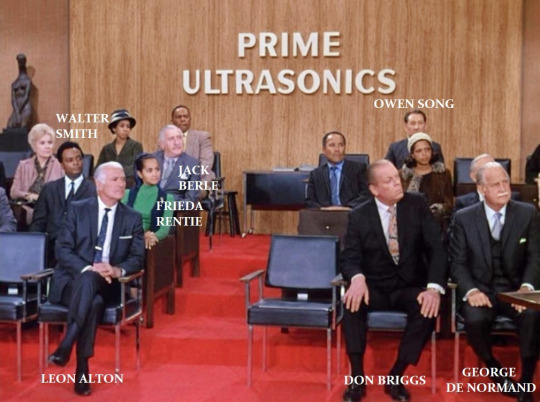
His final appearance with Lucille Ball was on “Here’s Lucy” in “Lucy The Crusader” (HL S3;E5) aired on October 12, 1970. He played Mr. Huntington, a stockholder for the Prime Ultrasonics Company. He is the only board member to speak.

He made his final screen appearance in an uncredited role, a politician in the 1976 biopic W.C. Fields and Me, starring Rod Steiger in the title role.
Briggs was married to Audrey Christie, who was a regular on the Desilu series “Fair Exchange” (1962-63) and played Mrs. Upson in Lucy’s Mame (1974).
He died on February 3, 1986 in Woodland Hills, Los Angeles, California, at age 75.

#Donald Briggs#Lucille Ball#Panama Lady#The Lucy Show#Here's Lucy#Eddie Collins#Vivian Vance#TV#CBS#The Adventures of Frank Merriwell
1 note
·
View note
Text
Things that existed: 1890′s-1914 (For fanfics, hc or rp!)
For me to reblog in the future with more.
Notes: I did not include most of the cigarettes, guns and alcohol. These are mostly American brands or international brands in the U.S at the time. Lots of wars, psychological studies, economic recessions, inventions, and media published in this time. This is obviously not an exhaustive list. Spans from a bit before canon to RDR 1′s epilogue
Pre 1890′s: (Just for fun)
1883: The Monopolist (Yes, an early rendition of the board game)
The game of Logic, Oscar Mayer, Pinocchio, Long John Silvers,
1884: First modern Cash Register (Imagine the gang trying to figure out how to open one of these)
1885: Dr. Pepper (the soda), first automobile
1886: Heinz Beans, Coco-Cola, Strange Case of Dr. Jekyll and Mr, Hyde by Robert Louis Stevenson
1887: Sherlock Holmes Book 1 by Arthur Conan Doyle
1888: Vending Machine, Drinking Straw, Four Roses (Bourbon Whiskey) Kessler Whiskey, Seltzer's for upset stomach/heartburn, Mum’s Deodorant, Hunts (the brand)
1889: Lysol
1890′s:
1890: The Picture of Dorian Gray By Oscar Wilde, Prom (The event for teens) Matryoshka doll, The Edison Talking Doll (Yes, those creepy ass ones), Lipton Tea, Vicks, Marston’s Brewery,
1891: Basketball, Rayon, Fig Newtons, Swiss Army Knife, Hormel,
1892: The second bicycle boom, the “modern” clothes washer, Maxwell Coffee House, Ithaca Kitty - an early paper doll, later stuffed toy?
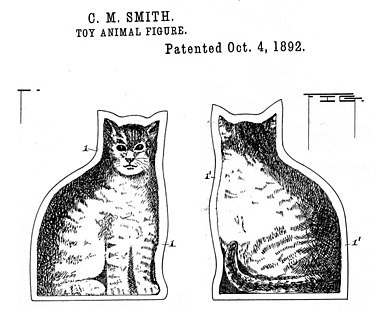
1893: Cream of Wheat, Juicy Fruit Gum, Johnson’s Baby, Good and Plenty, Wrigley’s Gum, popcorn maker, toaster, Diesel Engine, moving walkways, meth, Ferris wheel, The Jungle Book by Rudyard Kipling, Sunkist Co,
1894:Corn flakes, Phonograph, Silent Films, different fonts for typewriters? Hydrogen Peroxide (The fizzy stuff that burns like hell), lobster thermidor, mousetraps, Purina animal feed,
1895:Rugby leagues, Volleyball, Budweiser, T. Martzetii Dips, Whittaker’s Chocolate, X-rays,
1896: Cracker Jacks, Movie theaters, Frank Merriwell’s Books (A children’s series), Del Monte canning
1897: Jell-O, Cotton Candy, Grape-Nuts (cereal), mufflers, vasectomies, Smucker’s (jelly company), Dracula by Bram Stoker,
1898: Pepsi, Palmolive (Brand), steering wheel, heroin, Walker’s Shortbread, Nabisco, War of the Worlds by H.G. Welles,
1899: Martha white (food), Pall mall cigarettes', Wesson cooking oil, Lux soap, flashlights, revolving doors, first early telephone
1900′s:
1900: Wizard of Oz Book 1 released by L. Frank Baum, Chiclets, Hershey Bars, Kodak cameras, Triskets, escalators,
1901: Disposable Safety Razor, Sweethearts (The candy) the Scholastic Altitude Testing (Standardized Testing that American high schoolers take. Jack would have to take one, I think.) Necco’s candy, The Tale of Peter Rabbit by Beatrix Potter (All of her books then)
1902: Neon Lamps, Teddy Bear, periscope, air conditioning, polygraph tests, Peter Pan, The Virginian by Owen Wister - A western novel
1903: Kraft Food’s Company, Crayons
1904: Banana Split, tea bags, Ovaltine, Canada Dry, French’s (The brand), K-Y Jelly, Discoll’s Berries,
1905: Cadbury Dairy Milk, Hebrew National Brand, popsicles, RC Cola, Planters brand, Kellogg’s Brand, Arsène Lupin by Maurice Leblanc (Stories about a master thief)
1907: Gumball machine, rear-view mirrors, tootsie rolls, Hershey's kisses,
1908: Coffee filters, Ford Motel T engine, Hydrox cookies (Oreo’s lemony older brother), Milk-bone the biscuit (For Rufus), Anne of Green Gables, by L. M. Montgomery, Mr. Toad - the kid’s character,
1909: More modern lightbulbs, Pearson’s candy company, Tillamook Creamery, Phantom of the Opera by Gaston Leroux
1910: instant coffee, milkshake machines,
1911: Wall plugs, Nivea products, Midol (pain reliever), Crush Soda, Crisco, processed cheese, Mars brand,
1912: Edison Disc Record, Goo Goo Clusters, Oreos, LifeSavers candy, Lorna Doone Cookies, Tarzan by Edgar Rice Burroughs
1913: Zippers, Crossword Puzzles, Camel Cigarettes, Hellman’s Food company,
1914: Traffic Cone, Gasmask, Tinker Toys, Listerine, Salad Cream, Heath Bar, Mary Jane Candies, Grapico Soda, Turkish Delight, Mother’s Cookies (The rainbow animal cookies with sprinkles), Chicken of the Sea, TastyKake,
Bonus:
Modern Slang they would know.
Sorry for the tags, but I worked hard on this and I want it to go out.
Edit: Wow, thanks, guys! I didn’t expect this to gain traction. At all. Anyway, I’m a historian so feel free to send me asks about stuff like this! I will probably edit it for medical stuff.
#rdr 2#charles smith#arthur morgan#hosea matthews#dutch van der linde#van der linde gang#john marston#javier escuella#red dead redemption 2#sadie adler#sean macguire#jack marston#abigail marston
3K notes
·
View notes
Text
Frank Merriwell's Alarm: Or, Doing His Best: 12
Frank Merriwell’s Alarm: Or, Doing His Best: 12

Price: [price_with_discount]
(as of [price_update_date] – Details)

[ad_1]
MERRIWELL SERIES
Stories of Frank and Dick Merriwell
Fascinating Stories of Athletics
A half million enthusiastic followers of the Merriwell brothers
will attest the unfailing interest and wholesomeness of these adventures of two lads of high ideals, who play fair with them- selves, as well as with the rest of the…
View On WordPress
#Alarm#amazon best holiday reads#amazon best reads#amazon best reads 2020#amazon best reads list#amazon best reads of the month#amazon kindle best reads#Frank#Merriwells
0 notes
Text
The creation and influences of The Shadow
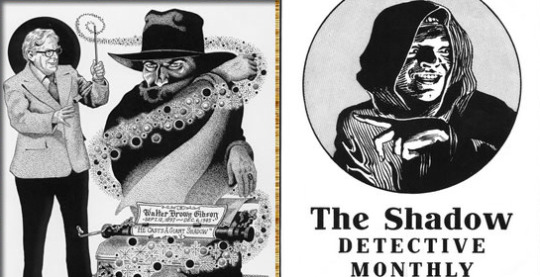
8:30 P.M on Thursday night. August 2, 1930. CBS' Detective Story Hour airs for the first time with a mysterious host/narrator. Radio writer Harry Charlot coins the name “The Shadow” for said narrator. When actor Frank Readick is brought to play the character, his sibilant voice, cruel tones and mocking laugh create such an impression on listeners, that suddenly Street & Smith is flooded with people asking for a Shadow Magazine that doesn’t exist.
Desperate to trademark the name, Street & Smith decides to revive their once dominant single-character magazine format, and hires newspaper magician Walter Gibson to create a character out of a voice. They offer him the chance to just use an existing Nick Carter story as a mold, and he declines. He cares little for them. Gibson instead had a long line of experiences as a writer, reporter and illusionist, working for some of the world’s greatest magicians, with a repertoire of stories under Houdini’s shadowy crimefighting organization that he carried with him past Houdini’s passing. He knew what he needed to do to make this work.
I believe that there is much to be learned about a character by looking at their influences, and that any attempts to plan out something's future should first start with a good look at it’s past. Much has been said about The Shadow’s monumental influence in not just many popular crimefighters over the decades, but also in the single-character magazine format that was revived through him. But what else influenced The Shadow, in turn? What were the other ingredients that went into his transformation? For this post we’ll be looking exclusively at statements from Gibson and acquaintances of Gibson on said influences
The emergence of The Shadow as a full-fledged Master of Mystery represented a phase in the cyclic evolution of mass fiction. Viewed in retrospect, the trend it sent would seem inevitable, but at the time no one expected it. For although its roots went back to the days of five-cent weeklies and dime novels that featured such figures as Nick Carter, Diamond Dick, Buffalo Bill, Jack Harkaway and Frank Merriwell, those publications had begun phasing out soon after 1900.
Ralston remembered that it had been the company’s policy to try out any magazine that had a catchy title or offered an opportunity in a new or neglected field. The Shadow qualified on both counts. The name was intriguing, and it offered a chance to revive interest in a heroic mode that might achieve fresh popularity if given a modern slant.
Because of Prohibition, we had the Mob, the St.Valentine's Day Massacre and all that stuff. And the idea was to create somebody formidable enough to beat down those gangs. Organized crime was assuming alarming proportions that only a modern crusader could crush
Unless S&S took advantage of a title in their grasp, somebody else might walk away with it. So Ralston instructed Blackwell to find a writer who could turn out such a story fast.
I spoke with Frank Blackwell, the Editor-in-Chief. I had been talking about doing some true crime articles for him. I wasn't thinking in terms of fiction when I met with Blackwell, but he said, "Look, we want somebody to create a character called The Shadow - and to do it fast. And I know you're a fast writer." And Blackwell said he wanted it to sound like he's real. "He's a massive crime fighter, but build him up any way you can."
I read quite a few detective stories off and on, but I wasn't particularly inspired by any. Street & Smith wanted a detective-type thing, and they said it could be based on Nick Carter. But I had never read any Nick Carters. I glanced at them to see what they were about, but I had completely different concepts.
As we discussed The Shadow, I suggested an opening scene with a cloaked figure emerging from a night fog to prevent a desperate young man from taking a suicide plunge from a high bridge. Thus befriended, the young man would swear loyalty to his rescuer and thereby become involved in exciting adventures with other persons who had been aided by the same benefactor, all being united in a common cause against crime
First and foremost, Gibson was given the following guidelines to create the character: make the character mysterious, make him modern, and make it sound like he’s real, traits that Gibson repeteadly stresses everytime he recounts the character’s origins. Gibson’s reporter background appealed to the editors who wanted “something fictional that sounded like fact”. Tasked with creating a believable and engaging character out of a living shadow, two specific icons were at the forefront of Gibson’s ideas: Dracula and King Arthur.

STARLOG: The Shadow quickly evolved from a lurking mystery man into a terrifying crimefighter. Why?
GIBSON: I liked anything that was ghostly, and I was very fond of Dracula and stories of that sort. The character had people guessing right from the start, and the pattern that inspired me was Bram Stoker's Dracula. Stoker had picked up many legends about vampires, and he told a friend that he was going to write a book on the subject. The friend said it was unbelievable and nobody was going to listen to him.
Stoker started writing it, and he realized that his friend was right. People would not believe it unless he put in some gimmick that would make them believe it. And what he did was write the book in form of a diary. So Dracula, this villainous character, crept in, and he got weirder and weirder as the story went on. It all sounded very real, and Stoker sold the book and collected the bet. I was confronted with something like that with The Shadow. I felt I had to make this nebulous character believable. He was sort of like a benign Dracula.
STARLOG: You also gave The Shadow mysterious devices for his cloak of tricks - right out of your background as a magician. I'm thinking specifically of the purple elixir he drank to amplify his strength in battle.
STARLOG: What fictional detectives influenced The Shadow?
GIBSON: Comparatively few. A lot of it came from the Oz books and King Arthur's knights. Those were my influences when I was young. There were cases where The Shadow carried plenty of hardware. You know, if you read the King Arthur stories - particularly the Howard Pyle versions - two knights would meet [on horseback], break their spears and one would be overthrown. He would get up and want to fight, and the other would void from his saddle and they would attack each other. Can you imagine getting off a saddle with all that armor weight? But when we read'em, we believed 'em. They were never bothered by their impediments, and The Shadow wasn't, either.
GIBSON: Well, there are such elixirs; I just didn't name what it was.
Along with his various disguises, he had been acquiring new agents with more to come; and I had outfitted him with a full panoply of weapons and gadgets that befitted his other title, “Knight of Darkness”, by which he was occasionally known.
Other more particular influences range from a personal repertoire of varied eclectic resources, three of which stand most: Edward Bulwer-Lytton’s The House and Brain, Maurice LeBlanc’s Arsene Lupin stories, and Frank Baum’s Oz books. In particular, Tim King, personal acquaintance of Gibson’s, claims that the Wizard of Oz was his favorite book.
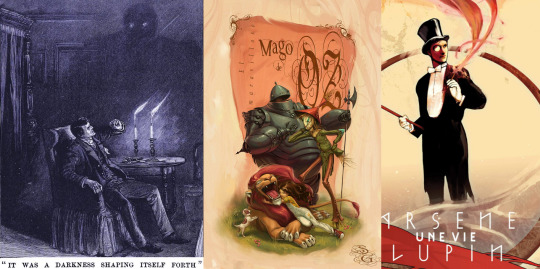
I enjoyed all types of ghost stories. Anything that was weird. Bulwer-Lytton's stories fascinated me. There was one called "The House and the Brain," in which a man is in this presumably haunted house where strange things happened. Every now and then, he would see blackness gather, and it looked like a shadow forming. I later used that technique in The Shadow's approach: crooks would be scared that something was lurking in the flap of a window shade. They thought they saw a shadowy form, but nobody was there.
Will Murray: Gibson told me that he was inspired by the weird shadow in this story in his earliest depictions of the Shadow. Specifically in The Living Shadow
As Will Murray and the late Bob Sampson both noted in their excellent studies of The Shadow, Walter Gibson was heavily influenced by another character from French literature, Arsene Lupin. Created by Maurice Leblanc (1864-1941), Lupin was a master thief with a score of false identities. Although a criminal, Lupin often functioned as a detective. In many novels, he combated German spies during World War I.
Maurice Le Blanc was a major influence. His many-identitied supercriminal Arsene Lupin lent a great deal to the development of The Shadow personality. Gibson borrowed from Le Blanc a type of plot in which the main clue is known, but ambiguous. In Le Blanc’s The Hollow Needle, the clue is a needle - but is it a sewing needle, a pine needle, or a natural rock formation?
(Side note: The Shadow story Ghost In The Manor features a character by the name of Dorothy Garland. This was written a couple of years before Judy Garland played Dorothy.)

A fan of Alexander Dumas, from him was picked up a technique of planting gimmicks in early chapters that could be brought out at a critical moment
Knowledge of the underworld was gleamed from Frank Packard’s Jimmie Dale stories, although Gibson preferred his railroad tales. Grey Seal is often referred to as one of the main precursors of the superhero, with his mask, signet ring, a civilian identity as a wealthy young man about town, a girl friend who sometimes used the pseudonym “Margot”.
(Discussing the creation of Lamont Cranston) To battle crime successfully and keep trusted agents constantly on the job, he would need a millionaire’s income and status to go with it. So I pictured him in a New Jersey mansion some twenty-odd miles outside New York City with a retinue of servants, late-model cars as required, an airplane at a nearby private airport, and best of all, a tower room equipped with all the latest radio gadgets, some that were not yet invented. All he needed was a name that would epitomize all that wealth, prestige and affluence: a name that would combine destinction with derring-do.
It should sound like the man described in Rudyard Kipling’s poem “If”, someone who could walk with kings yet keep the common touch. Perhaps two names of two syllables each, like Rudyard Kipling. In going through Houdini’s notes on magic, I had come across a double-syllable name like that: Baillie Cranston. It belonged to a theater owner in Scotland, and the “Cranston” sounded good, though the “Baillie” seemed wrong.
So I went through the alphabet, seeking a name to match it. When I reached the latter L, I hit upon “Lamont”, which was perfect. It sounded like a family name, which it was: and at the time it seemed to symbolize travel and wealth and standing in the field of international finance.
New identities or disguises were also introduced as needed. One was that of a doddering old gentleman named Phineas Twambley, who piloted himself with a heavy cane that could prove a lethal weapon when he sprang suddenly to action, shedding the years that were part of his disguise. Nothing was said of his background in the few stories where he appeared, but he was supposedly named after the famous showman Phineas T Barnum, to whom he claimed to be related

STARLOG: In the introductory Shadow novel, he was a nameless mystery man with a combat-ace past. Why the war backgrond:
GIBSON: There was that heroic stuff because of WW1. In the late '20s, they had pulps like War Aces, so it was natural to make him a heroic figure. And it was a good reason why he had to combat crime.
For seven or eight years, I was always planning what was to be his final identity.
STARLOG: Was there a real-life model for Allard?
GIBSON: Yes, two or three. One was a man named Colonel P.H Fawcett, who had flown into the jungles of Brazil and dissappeared. Every now and then, people thought he had been rediscovered. And there was another well-known aviator, Scotty Redfern. There were similar legends about him. So to have The Shadow come out of the jungle made it very timely.

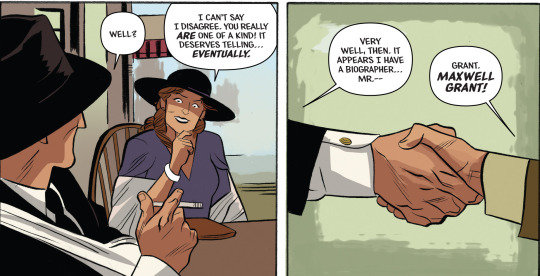
Maxwell Grant, Gibson’s pseudonym for many of the early Shadow stories, was an eponymous nod to magic dealers Max Holden (owner of the performance rights to the “Colored Shadows” illusion) and U. F. Grant, who in 1930 had written The Shadow Conjuring Act, a thirteen-page self-published mimeograph laying out alternative patter routines and presentation methods for existing shadow acts.
“The editors had decided to treat The Shadow as real rather than a fictional character. They wanted to play up the author as a raconteur so deeply engrossed in The Shadow’s archives that he had no time for anything else. So I was tasked with coming up with a name for myself”.

"As Maxwell Grant, I was ostensibly under The Shadow’s orders as much as the agents who obeyed his bidding or as the hapless victims of conniving criminals whom only The Shadow could rescue from the brink of doom. Even the title of the first story, The Living Shadow, established The Shadow as an actual personage and the central theme in the minds of avidly susceptible readers”.
“There was nothing that The Shadow couldn’t do, which made it all the easier to describe the things he did do”.

#pulp heroes#pulp fiction#the shadow#walter gibson#the shadow pulps#shadow magazine#dracula#king arthur#wizard of oz#arsene lupin#to those of you who might be wondering why judex or the phantom are not included#i cannot find any statements from gibson or acquaintances of him that confirm they were an influence#anthony tollin actually specifically rebukes judex#i only included those i have quotations for#there's a slightly bitter irony to the fact that being fresh and modern and believable are mentioned so often here#considering most people nowadays only know the shadow as the opposite of those things#if there's a takeaway from this post it's that i strongly recommend anyone who wants to write the shadow#to stay away from film noir and superheroes as the major basis#because there is a much bigger and vaster range of influences that went to the character#that informed much of what was great about the original stories#and that have a niche and a hook that those things don't#king arthur meets dracula is still a great sales pitch#go with that
33 notes
·
View notes